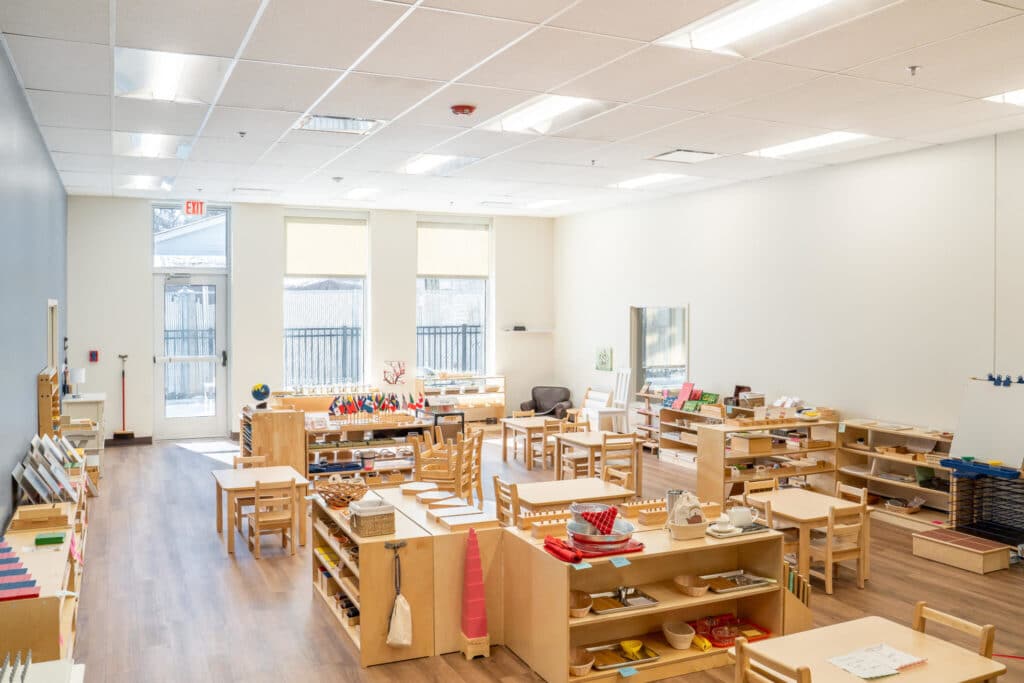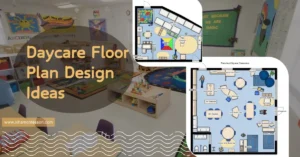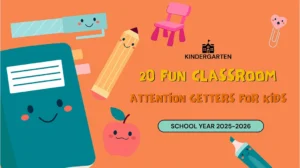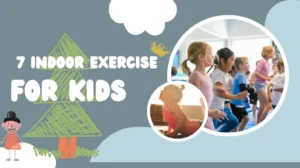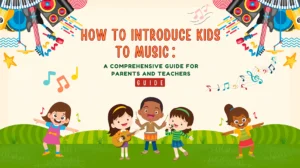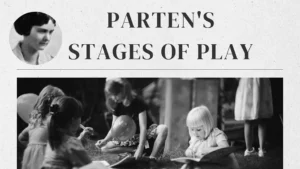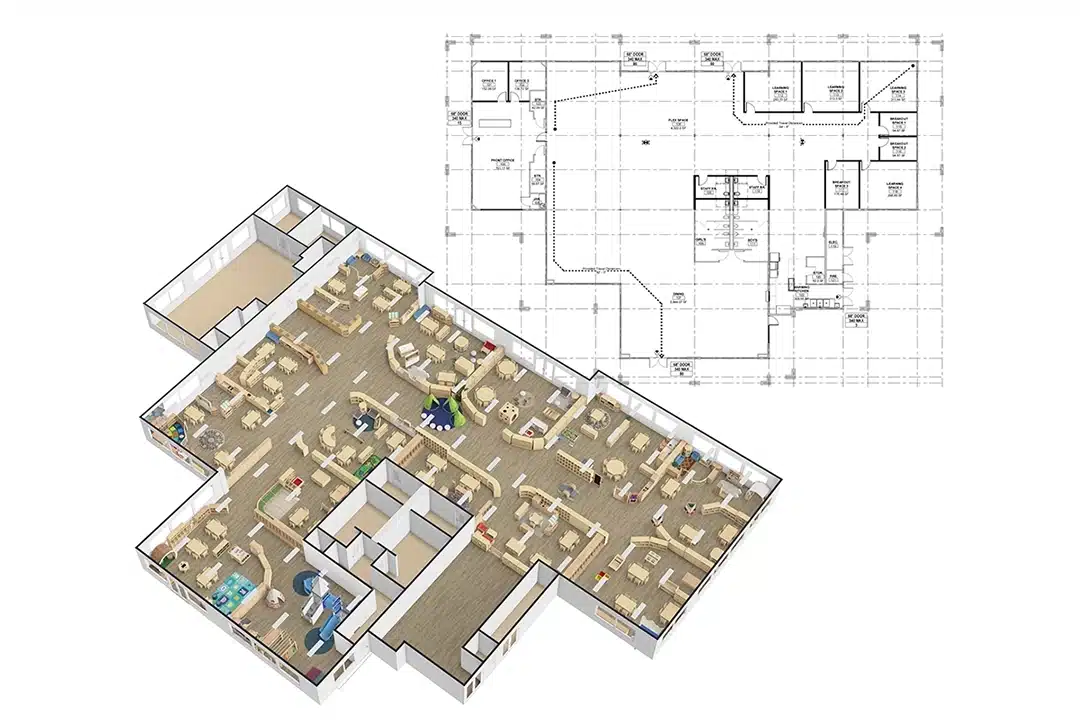Montessori classrooms provide a relaxing and respectful learning environment with minimal decorations and natural furnishings. Although not decorated in a traditional sense, Montessori classrooms are attractive and designed to be intuitive and conducive to a child’s needs. This allows for less stressful learning and creates a more holistic approach to teaching and learning about life.
A Montessori classroom is a one of a kind environment that helps promote independence and instill a love of learning into children at a young age. Through a clean, minimal aesthetic, the Montesorri method works with children to teach them about the real world and topics like science, language, and the arts. Most importantly, they do this without moving at a pace that allows a student to fall behind, creating an inviting environment for all children.
Why Are Montessori Classrooms So Inviting?
Even if you’ve never stepped foot in a Montessori classroom, you’ve likely heard how the Montessori classroom is specifically designed to play an important role in child development. Its minimalist and attractive design help children to make decisions without causing them to become overwhelmed. By creating a calm environment, you’re allowing the child to explore the lessons at their leisure.
A Montessori classroom is much more than just a room. It’s the first step of a lifelong journey to help students gain the skills and develop the independence they need to be successful. It is designed to be relaxing and aesthetically pleasing while stimulating each child’s curiosity and instilling a lifelong love of learning.
One of the greatest benefits of the Montessori classroom is how it creates an attractive hands-on learning environment. The emphasis of the curriculum and educational materials is on concrete learning rather than abstract learning. Students work on activities that teach math, sense, culture, language, and practical life lessons.
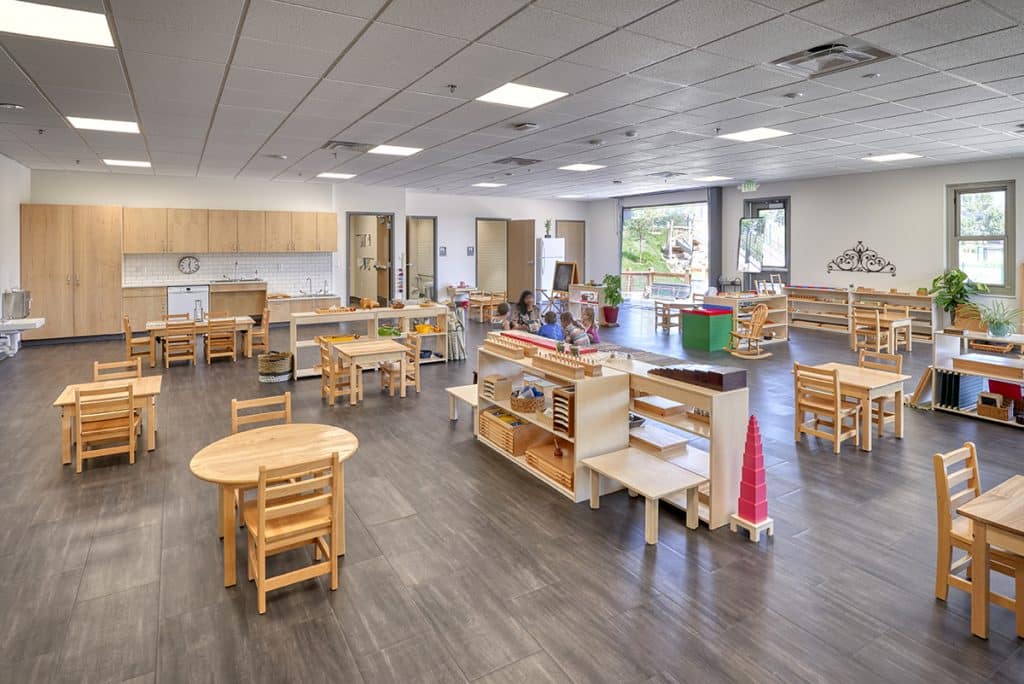
How to Setup an Attractive Montessori Classroom
To teach the Montessori method, a traditional Montessori classroom is generally comprised of five learning areas:
- Practical Life
- Sensorial
- Math
- Language
- Cultural
By designing the space this way, the classroom is intuitive and conducive to a child’s needs at multiple developmental stages—allowing them to progress at their own pace. Most Montessori classrooms feature:
- Designated learning areas. The Montessori classroom is divided into multiple learning areas dedicated to practical life, sensorial, math, language, and cultural experiences. By breaking up the room into designated learning areas, the children can take on experiences they encounter in the real world in a less overwhelming environment.
- Minimal wall decoration. Unlike a traditional preschool classroom, decorations in a Montessori classroom are kept to a minimum to maintain a relaxed and calming environment. Any decorations used in Montessori classrooms are generally both practical and simply designed.
- Natural furnishings. One of the most attractive features of a Montessori classroom is the use of natural furnishings. Instead of utilizing colored desks and chairs that are found in a traditional classroom, Montessori classrooms stick to a clean aesthetic with natural wood furniture. The Montessori design also favors integrating more circles into the layout instead of harsh rows.
- Soft lighting. Warm, soft lighting helps promote a comforting environment that reminds children of the warmth of their home. This provides a much more calming environment than traditional fluorescent lighting.
- Structured organization. The Montessori classroom prides itself on its relaxing atmosphere, which is aided by using a neat and practical organization method that encourages self-driven learning. Using predictable organization methods for classroom supplies, toys, and educational items helps the children to build confidence.
While no two Montessori classrooms are the same, utilizing the features above helps to optimize the way children interact with the environment and with each other.
Learning Areas to Include in a Montessori Classroom
A Montessori classroom is broken up into five learning areas, creating a place where children have a sense of freedom and enhance their independent learning, self-discipline, and exploration skills. The five areas of a Montessori classroom are practical life, sensorial, math, language, and cultural. And of course, some Montessori classrooms decide to incorporate additional learning areas as well.
Practical Life
When children are in the practical life area of the Montessori classroom, they’re working on developing and improving life skills. By working on skills that help them excel in the real world, they simultaneously develop character traits such as confidence, independence, and caring. Activities children participate in range from gardening, sewing, making bubbles, cleaning, folding laundry, using a lock and key, setting a table, and many more skills that allow them to build a sense of independence, respect for others, and help to refine their hand-eye coordination.
To set up Montessori students for success in the real world, they’ll learn about:
- Self-care
- Environment
- Manners
- Courtesy
- Control of movement
- Concentration
- Independence
Sensorial
Sensorial activities allow a child to explore their senses, discover the different elements of their environment, and help children in discrimination and order. In this learning area, students will be exposed to sensorial tools to help them learn how to classify and organize objects by their shape, color, and size.
Sensorial activities will work to enhance their skills related to:
- Vision
- Touch
- Smell
- Taste
- Hearing
- Movement
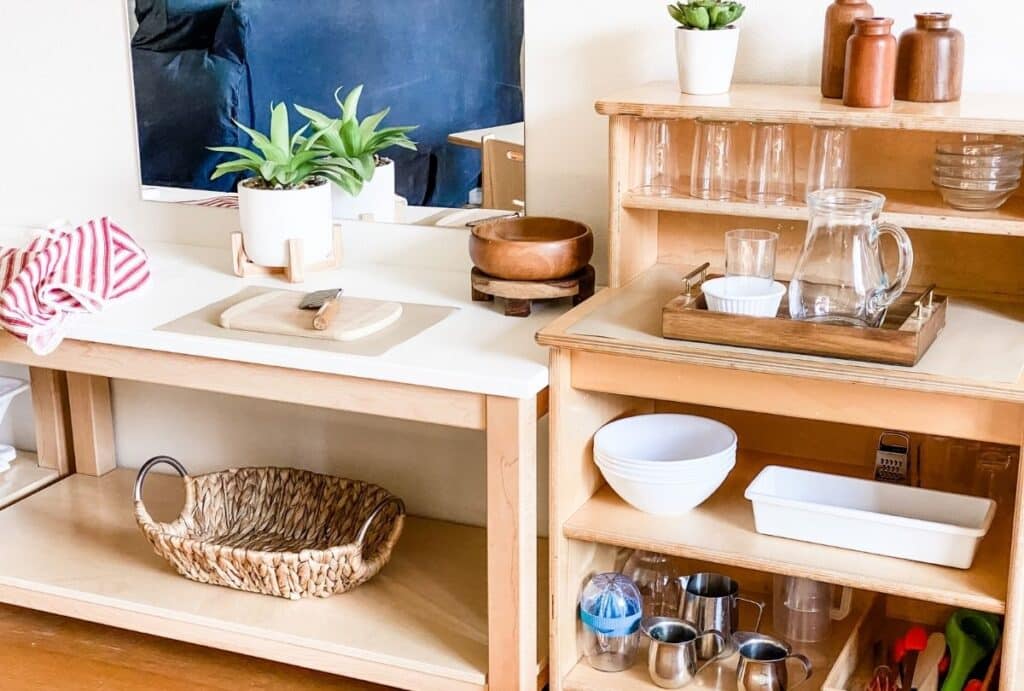
Math
In a Montessori classroom, children start by learning how to identify and count numbers. Once the children are confident in their counting abilities, they’ll begin to learn the decimal system, geometry, and other areas of mathematics. To teach these concepts, Montessori teachers use teaching aids like wooden number cars, bead stairs, and more to allow them to discover a love for math.
The math curriculum helps Montessori students to learn:
- Counting
- Decimal system
- Memory work
- Concrete abstraction
- Arithmetic operations
- Geometry
Language
In the Montessori environment, children are set up to succeed in all areas, including language—phonetics, composition, and more. Montessori teachers utilize Montessori materials including the books for phonetics, wooden alphabet games, and pencils for free drawing. These methods allow the children to develop and hone their language skills through fun, educational activities that make learning a rewarding experience.
When in the language area of the classroom, students will be focused on:
- Phonetics
- Vocabulary
- Grammar
- Word usage
- Sentence structure
- Composition
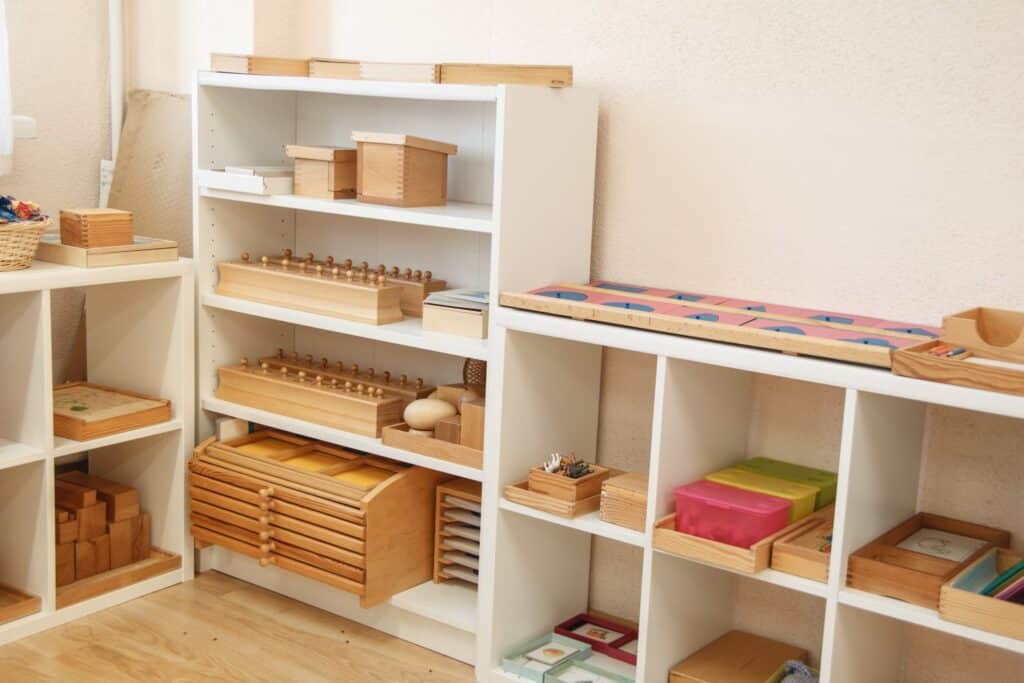
Cultural
Cultural studies in a Montessori curriculum introduce children to the physical world that surrounds them. From foreign language to zoology and geography, Montessori students get to dabble in it all—providing the children with an opportunity to explore the larger world. The cultural area is one of the areas in the classroom that is constantly changing and evolving, allowing the students to continually learn about a variety of cultural topics.
While teaching children around the world around them, they’ll be learning:
- Geography
- Zoology
- Science
- Botany
- Spanish
- Mandarin
Additional Areas of Montessori Learning
Science
When a child is in the science learning area of a Montessori classroom, they’re able to explore and experience different areas like physics, geology, botany, and astronomy. The science learning area provides an area to cultivate the child’s fascination with the universe while observing nature and the world around them.
Arts
Self-expression is important for young, developing children and the Montessori curriculum helps to promote their artistic voice. The art curriculum includes activities like painting, drawing, music, singing, movement activities, and crafts.
When creating your safe learning environment, find a way to incorporate each of these learning areas into your Montessori classroom to ensure your students are being encouraged and allowed to think freely and develop at their own pace.
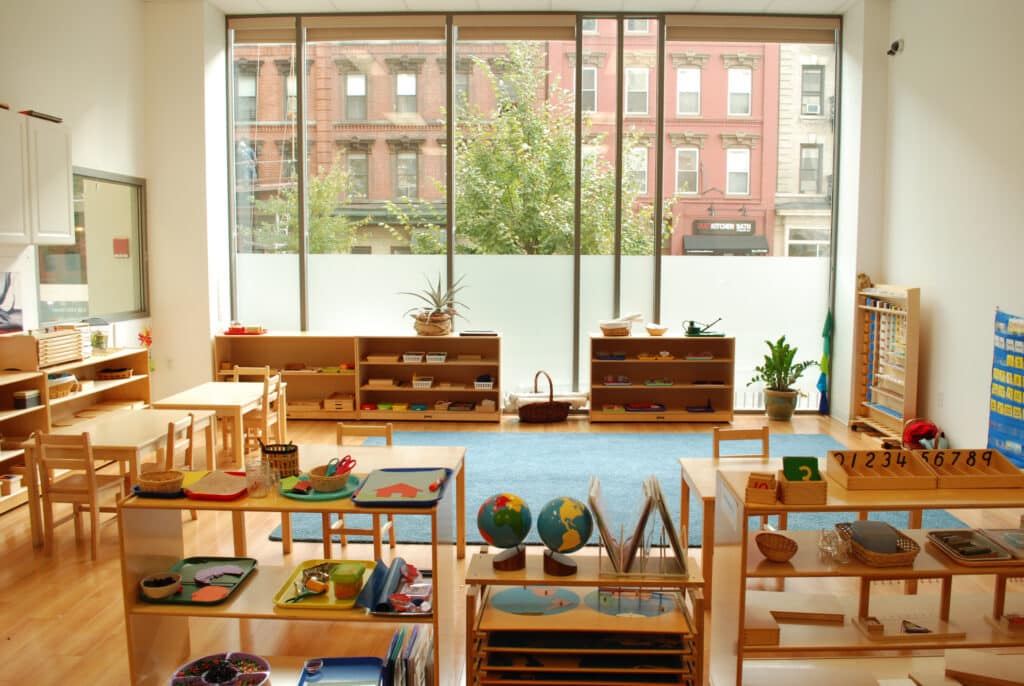
The Benefits of the Montessori Classroom Design
The Montessori classroom features a simple, neat aesthetic that provides numerous benefits for students. Some of the advantages of the Montessori classroom design include:
- Minimal Distractions – A traditional classroom setting is designed with bright, bold colors and decorations—providing ample distractions for students and creating a chaotic space. The Montessori classroom limits the amount of visual stimulation in the space to minimize any distractions, promoting a relaxed and calm environment. By eliminating common distractions from the classroom, Montessori teachers can facilitate better engagement in group activities.
- Learning Areas – The specific learning areas of the Montessori classroom helps to promote independent thinking and allow the students to develop skills that are sure to benefit them throughout their entire life. In each of these learning areas, the children will engage in self-directed activity, hands-on learning, and collaborative play that will boost their sense of self.
- Comfortable Aesthetic – With the soft lighting and minimal decoration, a Montessori classroom is much more inviting than a traditional classroom. This can be extremely beneficial for young children who might be more prone to separation anxiety. A Montessori classroom is much more welcoming and less intimidating, creating a safe space for children to learn and grow.
- Accessible Learning Materials – The Montessori classroom promotes independence. Children aren’t able to build skills if they aren’t allowed to do so. To promote this way of thinking, a Montessori classroom makes every toy and educational material easily accessible to all students, instead of storing things away on high shelves.
- Child-Led Learning – The design and layout of the Montessori classroom don’t follow a specific curriculum to a tee. It promotes self-expression in a space where children get to learn discipline and develop real-world habits through its structure and organization.
There are many benefits of a Montessori classroom which makes it a great environment for students to build and hone their skills and learn new subjects. These developmental years are important to instill confidence and prepare a student for the learning experience that is to come later in life, which can be done by creating an inviting and educational Montessori classroom.
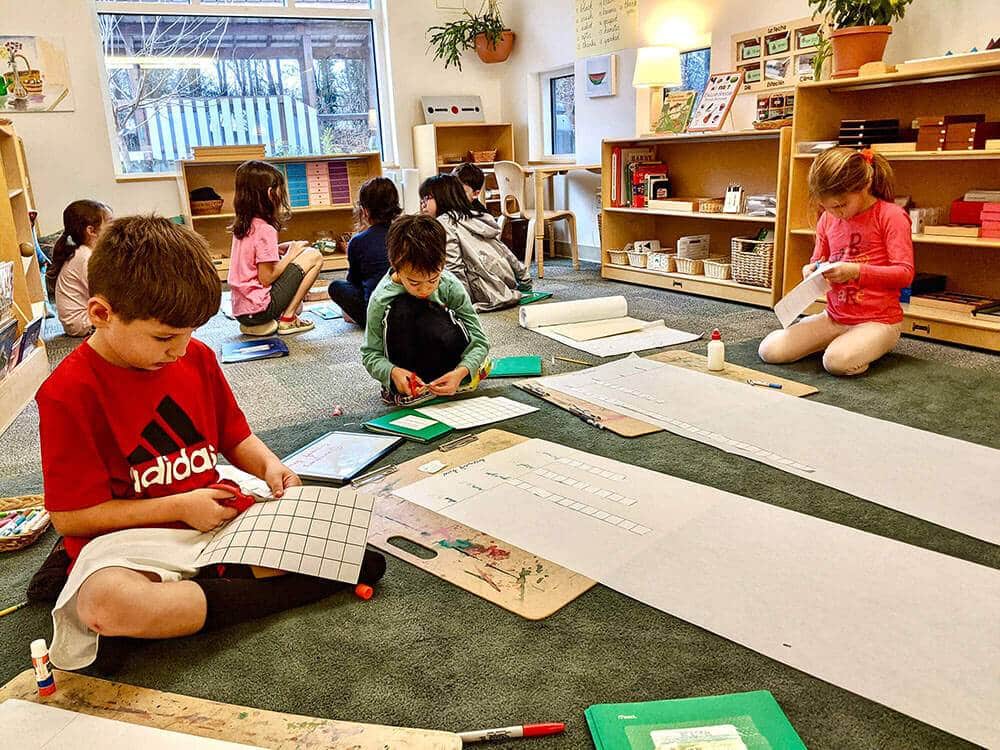
How to Create an Attractive Montessori Inspired Classroom
Setting up a Montessori classroom can seem overwhelming at first because of how many “rules” there are, but it’s easy to do by following a few simple steps. If you’re looking to set up an attractive and inviting Montessori classroom, even if it’s one for your own home, here are a few tips for you to create your relaxing space:
Use Form and Function
In the Montessori classroom, every part of the space should be attractive and inviting. It’s important to install beautiful furniture—shelves, tables, and chairs. When possible, incorporate educational materials that are made of real wood instead of plastic, which is commonly used in a traditional classroom. Using the Montessori Method, the children will learn to take care of higher quality materials because of the responsibility you are trusting them with.
Don’t Include a Focal Point
Unlike the traditional classroom when desks are set up in rows facing the whiteboard, a Montessori classroom doesn’t include a focal point. Instead, the Montessori classroom utilizes round shapes. The entire classroom acts as an engaging learning space instead of being focused on structure, promoting both individual and collaborative projects.
Less Is More
Simplicity is key when it comes to designing your Montessori classroom. When choosing your toys and educational materials, don’t cram the shelves. When the space gets too cluttered, it can cause the children to get confused and overwhelmed, making it harder for them to concentrate and make choices independently.
Setup from a Child’s Perspective
Your goal should be to make the Montessori classroom an inviting place for children to learn and grow. To get a better understanding of how they’ll see the room from their perspective, walk around on your knees as you set everything up. Check that each of the learning areas is accessible when walking through the room holding their projects.
Use Child-Sized Furniture
Your Montessori classroom must be inviting to young children. By incorporating classroom furniture that is too large for the space, you can make the room seem much more overwhelming. It can also make the learning areas much less accessible, causing endless frustration for the students. Choosing minimal, child-sized wood furniture into the space will make it much more attractive.
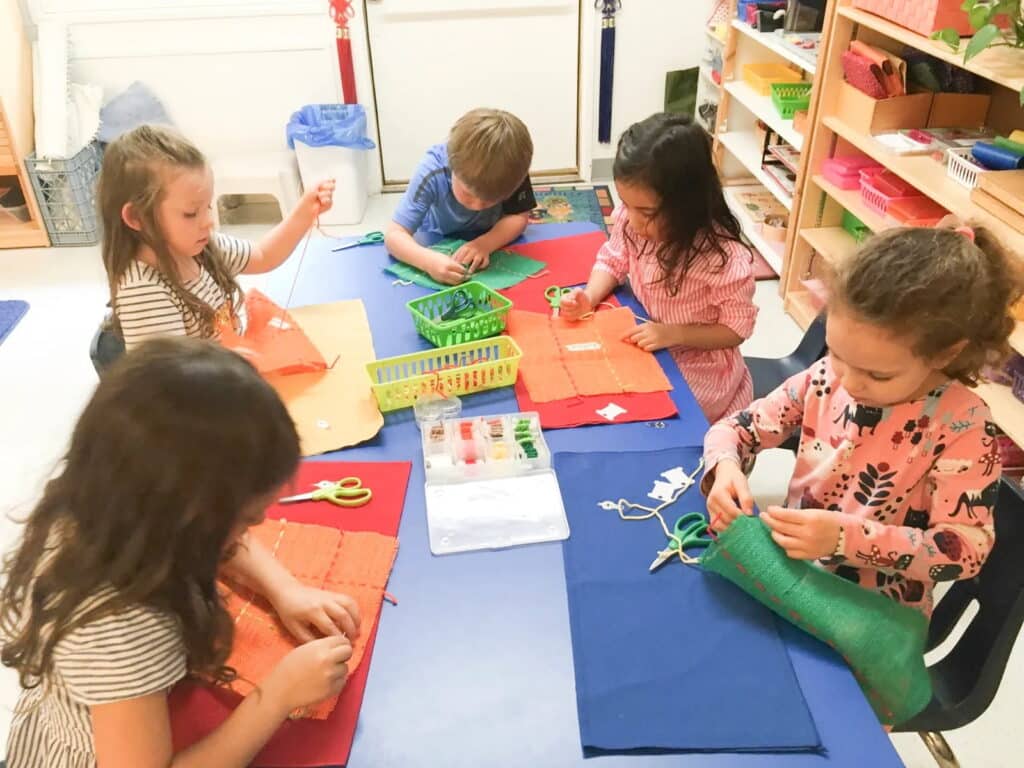
Incorporate Beauty Into the Space
Even though Montessori classrooms tend to be more on the minimal side, you can still incorporate art and plants into the space. When adding these to your classroom, make sure you are displaying art and plants at the child’s height for them to enjoy.
Build Out Learning Areas
When organizing your classroom, separate the classroom into individual learning areas for practical life, math, culture, language, and sensory activities that will help the Montessori students develop and hone both practical and educational skills.
Keep the Space Organized
Maintain an organized and clutter-free classroom to instill a sense of calm with your students. Keep decorations, toys, and educational materials to a minimum to avoid overcrowding the classroom and causing a sense of distraction and chaos.
Give Everything a Designated Place
When adding materials and toys to your classroom, create a place for everything, and keep everything in its place when it’s not in use. Young children have a particularly strong sense of order and keeping things in place will help them learn where things belong—and teach them to put things away where they belong.
Set Up the Space to Maximize Independence
Set up your students to develop a sense of independence. To do this, you can organize activities and materials on eye-level shelves and baskets so everything the young children need is easily accessible—look for ways to make it easier for the child to help themselves.
Additional Tips for Setting Up Your Montessori Classroom
- Rotate the cultural learning area on a consistent and regular schedule
- Use rugs to separate the spaces in the classroom and make the room more comfortable
- Limit the number of wall decorations you bring into the space
- Avoid toys and educational materials with batteries and choose wooden toys when possible
- Utilize the real world in your sensorial learning area by incorporating seasonal elements for the children to explore, like leaves in the fall, sand in the summer, snow in the winter, or flowers in the spring
- Ensure that snacks and beverages are easily accessible at the children’s level, teaching them to nourish their body on their own
- Think practical and don’t over plan the layout or materials you’d like to include, the more minimal and clean the classroom, the more inviting it will be for students
- Keep a step stool accessible for the students in both the classroom’s kitchen and bathroom to build up their independence with daily activities like hand washing and meal prep
- Incorporate activities like sewing, knitting, and cleaning that promote developing life skills and improving the child’s concentration
- Create a Montessori classroom with a comfortable, designated space where students can read or have books read to them
- Install open shelves that are easy to organize and easy for students to reach
- Make sure things are at the child’s height—educational materials, toys, plants, furniture, and anything the children will be expected to use
- Group your educational toys and learning materials together in the appropriate curriculum areas to make it easy for children to find what they’re looking for without getting frustrated or overwhelmed
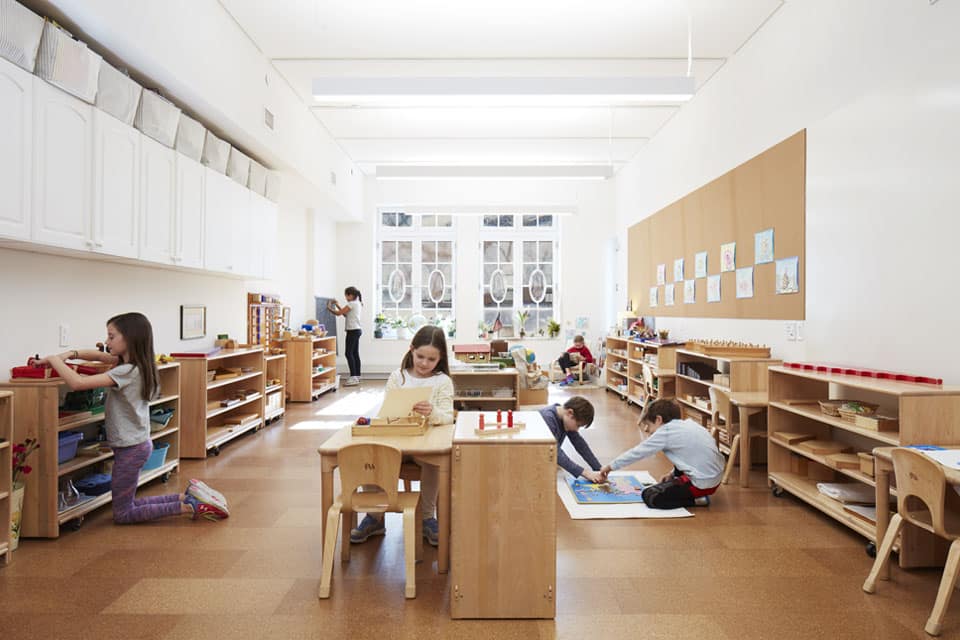
Your main focus when setting up a Montessori classroom should be to keep a clean and welcoming environment with minimal distractions to help develop the students’ sense of independence. By following these recommendations, you’ll create an attractive and inviting classroom that allows the students to develop their skills and flourish at their own pace.

